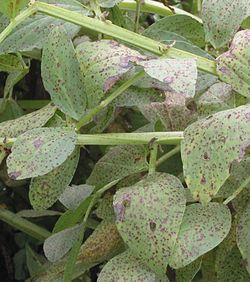Difference between revisions of "AY Honors/Fungi/Botryotinia/es"
From Pathfinder Wiki
(Created page with "Libro de Respuestas de Especialidades JA/Naturaleza/Hongos/Botrytis") |
(Created page with "</noinclude> thumb|180px|Botrytis Botryotinia es un género de hongos ascomicetes que produce varias enfermedades vegetales. La m...") |
||
| Line 1: | Line 1: | ||
<noinclude></noinclude> | <noinclude></noinclude> | ||
[[Image:Tuinboon Chocoladevlekkenziekte.jpg|thumb|180px|Botrytis]] | [[Image:Tuinboon Chocoladevlekkenziekte.jpg|thumb|180px|Botrytis]] | ||
| − | Botryotinia | + | Botryotinia es un género de hongos ascomicetes que produce varias enfermedades vegetales. La mayoría de las formas anamórficas de Botryotinia se incluyen en el género de hongos imperfectos Botrytis. El género incluye 22 especies y un híbrido. |
Plant diseases caused by Botryotinia species appear primarily as blossom blights and fruit rots but also as leaf spots and bulb rots in the field and in stored products. The fungi induce host-cell death resulting in progressive decay of infected plant tissue, whence they take nutrients. | Plant diseases caused by Botryotinia species appear primarily as blossom blights and fruit rots but also as leaf spots and bulb rots in the field and in stored products. The fungi induce host-cell death resulting in progressive decay of infected plant tissue, whence they take nutrients. | ||
<noinclude></noinclude> | <noinclude></noinclude> | ||
[[Category:Adventist Youth Honors Answer Book|{{SUBPAGENAME}}]] | [[Category:Adventist Youth Honors Answer Book|{{SUBPAGENAME}}]] | ||
Revision as of 13:42, 12 June 2015
Botryotinia es un género de hongos ascomicetes que produce varias enfermedades vegetales. La mayoría de las formas anamórficas de Botryotinia se incluyen en el género de hongos imperfectos Botrytis. El género incluye 22 especies y un híbrido.
Plant diseases caused by Botryotinia species appear primarily as blossom blights and fruit rots but also as leaf spots and bulb rots in the field and in stored products. The fungi induce host-cell death resulting in progressive decay of infected plant tissue, whence they take nutrients.

